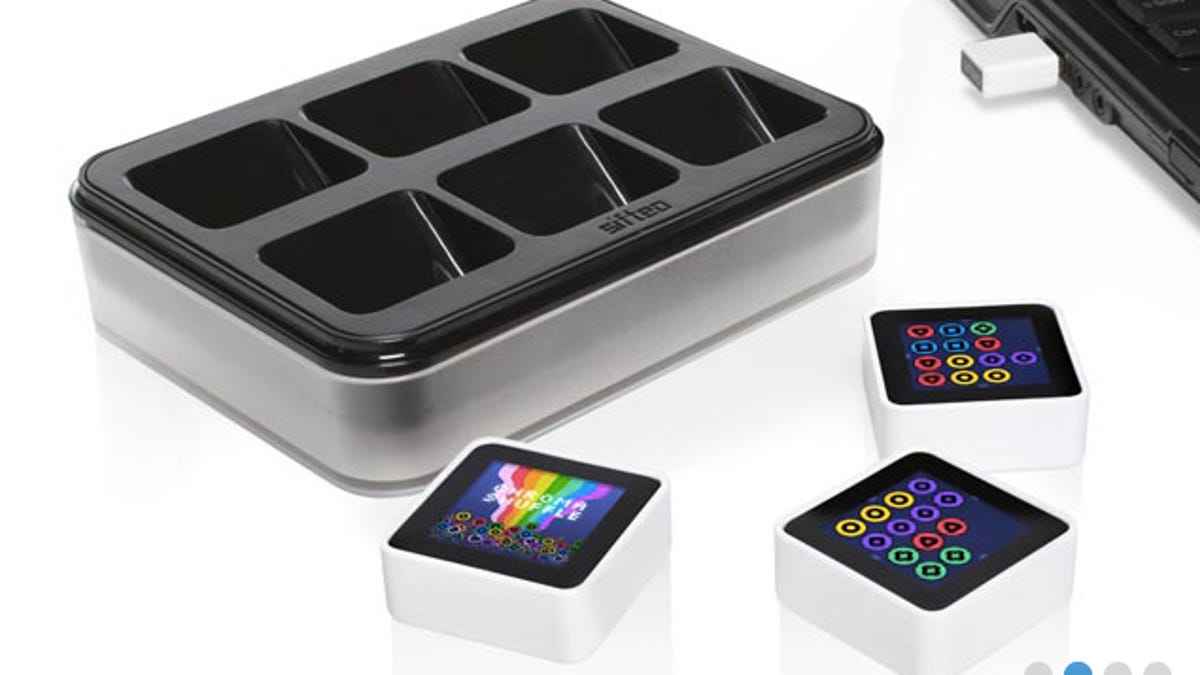Sifteo's hot Cubes born of ubiquitous computing heritage
Known mainly as an innovative games platform, the San Francisco start-up's first product is aimed at fulfilling a 20-year-old vision of computers being everywhere and on every surface.

SAN FRANCISCO--Can toys be part of a computing movement?
At Sifteo, a start-up here launched by two MIT Media Lab graduates, the answer is an emphatic yes. And while the world may be focused on the innovative play offered by the young company's motion-aware Cubes, the founders have higher aspirations than just being a toy company.
This evening, at a party in San Francisco, Sifteo is publicly launching its first product--a set of small electronic cubes (see video below) that communicate with each other wirelessly and enable a wide variety of casual digital games. The cubes come in sets of three--for $150. Already, much has been written about the company and its offering. But few have delved into the inspiration that led Sifteo founders Dave Merrill and Jeevan Kalanithi to take the path they've gone down.
Asked about the genesis of their ideas, Merrill and Kalanithi waste no time in pointing to a vision expressed in 1991 by digital philosopher Mark Weiser who believed that the future of technology rested on a broad, ubiquitous computing platform anchored by walls, pads, and tabs.
To hear Merrill and Kalanithi talk about it now, wall- and pad-style computing has already taken hold of popular culture: systems like Microsoft's Kinect and Nintendo's Wii, "Minority Report"-style computers, CNN's "magic wall," and of course, Apple's iPad and other tablets, have met many of Weiser's criteria for walls and pads. But that left tabs.
Weiser saw a future of tabs--"inch-scale machines that approximate active Post-It notes" which could replace the nearly endless number of small-scale display surfaces we already have in abundance. "Look around you," he wrote, "at the inch scale, [there are] wall notes, titles on book spines, labels on controls, thermostats, and clocks, as well as small pieces of paper."
Altogether, Weiser believed that this larger ubiquitous computing platform would soon come to dominate our daily lives. "Hundreds of computers in a room could seem intimidating at first," he thought, "just as hundreds of volts coursing through wires in the walls did at one time. But like the wires in the walls, these hundreds of computers will come to be invisible to common awareness. People will simply use them unconsciously to accomplish everyday tasks."
And this is where Sifteo thinks it can play a role in helping bring Weiser's ideas into the mainstream. As Weiser--who died in 1999--forecast, "Tabs are the smallest components of embodied virtuality. Because they are interconnected, tabs will expand on the usefulness of existing inch-scale computers such as the pocket calculator and the pocket organizer. Tabs will also take on functions that no computer performs today. For example, Olivetti Cambridge Research Labs pioneered active badges, and now computer scientists at PARC and other research laboratories around the world are working with these clip-on computers roughly the size of an employee ID card. These badges can identify themselves to receivers placed throughout a building, thus making it possible to keep track of the people or objects to which they are attached."
This may not sound altogether like a games platform--Sifteo's Cubes today offer little more than the opportunity to play unusual and interesting small-scale games that get a lot of their appeal from the cubes' cool technology. But it's clear from the way Sifteo has designed its platform that Merrill and Kalanithi have a much bigger idea in mind.
The best evidence of that is that they plan on releasing a software development kit for the cubes that will let third parties design just about any kind of game or other application for the tiny devices. Weiser may have seen tabs as mere containers for applications, Merrill and Kalanithi argued, but Sifteo wants its cubes to be the actual interfaces for and endless collection of apps. "Screens are so powerful," Kalanithi said of Sifteo's thinking when it came to creating its first product. "Whey don't we just add a screen and see what happens when you mix these things together."
And because the company is smart to recognize that it doesn't "have a monopoly on creativity," as Kalanithi put it, it could be interesting to see what outside developers come up with. It could be new, interactive mapping, or a way to view e-mail or tweets on the cubes. Or anything in between, he suggested.
In truth, most third-party applications are likely to be games--since developers will want to appeal to consumers, and Sifteo is marketing its cubes as a game system of sorts. But that doesn't mean everything will be built around play. Merrell said that as Sifteo moves forward, its team has a mandate to remain focused on ensuring that its products aspire to a version of Weiser's vision of ubiquitous computing while also making sure that the products "fill a very specific niche in a person's life."

